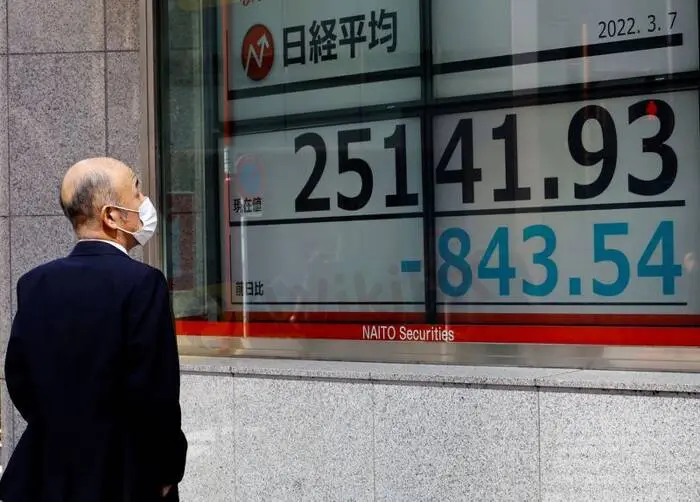简体中文
繁體中文
English
Pусский
日本語
ภาษาไทย
Tiếng Việt
Bahasa Indonesia
Español
हिन्दी
Filippiiniläinen
Français
Deutsch
Português
Türkçe
한국어
العربية
U.S., European shares advance as euro dives to lowest since 2017
Abstract:A global stocks sell-off extended into the Asia morning on Wednesday, as growing fears about the global economy forced investors to dump riskier assets in favour of safe havens such as the U.S. dollar and government bonds.
Key U.S. equity indexes ended higher after choppy trade on Wednesday on a boost from strong earnings from Microsoft and Visa, as commodity stocks lifted European shares to their first gain in four sessions.
The euro dropped to its weakest since 2017 after Russia halted gas supplies to Bulgaria and Poland, and investors fretted more about the regions economy.

The dollar continued its surge, on course for its biggest monthly gain since January 2015 as expectations mounted that the U.S. Federal Reserve will hike interest rates aggressively in coming months and the American economy will be stronger than the euro zone.
The Dow Jones Industrial Average rose 0.19% to end at 33,301.93 points, while the S&P 500 gained 0.21% to 4,183.92.
The Nasdaq Composite dropped 0.01% to 12,488.93.
Microsoft Corp jumped 4.8% % and Visa Inc surged 6.5%% on strong earnings, helping boost the S&P 500.
Some of Wall Streets biggest names have reported results this week, with investors seeking a counterweight to the deluge of negative news that has pounded stocks.
Google-parent Alphabet Inc fell 3.6% as slowing YouTube ad sales pushed quarterly revenue below expectations. Boeing Co dropped 7.5% after it disclosed $1.5 billion in abnormal costs from halting 777X production.
The pan-European STOXX 600 rose 0.7% after having hit six-week lows at the open, with miners and oil stocks both gaining.
German shares, which underperformed through the session, rallied at the close.
European corporate earnings were mixed. Credit Suisse reported another quarterly loss and Deutsche Bank warned the Russia-Ukraine conflict could hurt annual earnings.
Russia cut the flow of natural gas to Bulgaria and Poland for rejecting its demand to pay in roubles, taking direct aim at European economies. This led investors to sell euros and snap up U.S. dollars.
MSCIs benchmark for global equity markets retreated 0.17%. Emerging markets stocks fell 0.54%.
U.S. Treasury yields rose, as investors awaited greater clarity on the “restrictive” policy the Fed plans to pursue next week to combat inflation by curbing economic growth.[US/]
The euro dropped as low as $1.0512, its weakest against the dollar since May 2017. Analysts cited the war in Ukraine and growing concerns that the blocs economy will fall into recession this year.
“The euros blatant inability to rally on hawkish comments by European Central Bank members means lingering vulnerability to an external environment negatively affected by an ever-concerning situation in Ukraine and generalized USD strength,” ING FX strategists wrote in a note to clients.
The dollar index measuring the greenback against a basket of rivals, hit a five-year high.
“The U.S. dollar benefits from the prospect of an ongoing flight to safety liquidity bid,” said Jeremy Stretch, head of G10 FX strategy at CIBC.
GRAPHIC: Euro vs U.S. dollar https://fingfx.thomsonreuters.com/gfx/mkt/zdpxogxldvx/euro%20dollar%202.PNG
CHINESE REBOUND
There was more selling in Asia, with MSCI‘s broadest index of Asia-Pacific shares outside Japan down 0.82% after hitting its lowest since mid-March. Tokyo’s Nikkei fell 1.17%.
Australian shares lost 0.78% as inflation hit a 20-year high, bringing interest rate rises closer.
Battered Chinese stocks bucked the trend, gaining almost 3% as data showed faster profit growth at industrial firms in March than a year earlier.
In the previous session, China stocks fell to their lowest in two years on fears that persistent COVID lockdowns would hurt economic activity and disrupt global supply chains.
Oil prices edged higher on ongoing global supply concerns, with Brent crude futures finishing up 33 cents to $105.32 a barrel and U.S. crude settling up 32 cents at $102.02 a barrel.
Spot gold prices hit a more than two-month low and were last down 1.05% by 4:34 p.m. EST (2034 GMT), under pressure from the dollars rally. U.S. gold futures GCv1 settled down 0.8% at $1,888.70 per ounce.[GOL/]
(Additional reporting by Kanupriya Kapoor and Joice Alves; Editing by John Stonestreet, Mark Heinrich, David Gregorio, Nick Zieminski and Jonathan Oatis)
Disclaimer:
The views in this article only represent the author's personal views, and do not constitute investment advice on this platform. This platform does not guarantee the accuracy, completeness and timeliness of the information in the article, and will not be liable for any loss caused by the use of or reliance on the information in the article.
WikiFX Broker
Latest News
Geopolitical Events: What They Are & Their Impact?
Volkswagen agrees deal to avoid Germany plant closures
Top 10 Trading Indicators Every Forex Trader Should Know
WikiEXPO Global Expert Interview: Simone Martin—— Exploring Financial Regulation Change
TradingView Launches Liquidity Analysis Tool DEX Screener
MultiBank Group Wins Big at Traders Fair Hong Kong 2024
'Young investors make investment decisions impulsively to keep up with current trends' FCA Reveals
Why Do You Feel Scared During Trade Execution?
CySEC Settles Compliance Case with Fxview Operator Charlgate Ltd
Scope Markets Review: Trustworthy or Risky?
Currency Calculator


